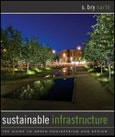Table of Contents
Foreword by Cliff Garten.Preface.
Introduction.
Part 1- Process and Systems of Sustainable Design.
Chapter One: The Process of Applied Sustainable Engineering Design.
Framing the Design Challenge.
Creating a New Paradigm for Design.
Integrating Disciplines: Architects and Engineers.
The Sustainable Design Team - An Engineer?s Perspective.
Design Drivers for Sustainable Infrastructure Systems.
Project Drivers.
Establishing Project Values and Setting Goals.
Defining Desired Outcomes and Metrics.
Creating Frameworks and Action Plans.
Design Strategies.
Implementing the Process.
Applying Integrative Design on Old Mint Plaza.
Goal-Setting at Aquatera, Florida.
Chapter 2: Sustainable Infrastructure Frameworks.
Establishing a Framework.
Green Building Rating Systems - Helping or Hurting? An Architect’s Perspective.
Using Sustainable Infrastructure Frameworks.
Using Frameworks for Different Types of Development.
Framework #1: Pillars of Sustainability.
Pillars of Sustainability at The Great Wall Eco Villages.
PlaNYC: Pillars of Sustainability in Action.
Framework #2: The Scale-Density Framework.
Applying the Scale-Density Framework to New Development.
Framework #3: The Transect.
Using the Transect to Redevelop Tehachapi.
AIA COTE "Ten Measures of Sustainability".
Framework #4: The Built Form-Ecology Framework.
Balancing Human and Ecological Development on the Santa Lucia Preserve.
Table of Ecosystem Services.
Synergy and Sustainable Community Design.
One Planet Living Framework - Sonoma Mountain Village.
Endnotes.
Part 2- Sustainable Resource Systems.
Chapter 3: Water Conservation & Supply.
The Aspen Institute: Energy and Environment Program.
Water Management Plans.
Achieving Water Balance.
Looking at a Water Balance for a Buddhist Center in California.
Water Balance on the "Ahwahnee" Project.
The Living Building Challenge - WATER.
Analyzing Water Sources.
Groundwater.
Surface Water.
Rainwater.
Brackish Water.
Seawater.
Stormwater.
Water Supply Strategies.
Reduce Demand / Conserve Water.
Improvements to Infrastructure.
Expansion of Existing Water Resources.
Rainwater Harvesting for a residential property in Sausalito.
Endnotes.
Chapter Four: Inegrated Water Management.
Water as Resource, Not Waste Product.
Impacts of Modern Wastewater Practice.
Redefining Waste Water.
Integrated Stormwater Management.
Effects of Development on Stormwater Runoff.
Low Impact Development Design Principles.
Benefits of LID Stormwater Management.
Order of Design Operations.
Urban Stormwater Treatment Strategies in San Mateo County.
Urban Stormwater Treatment Strategies.
Extensive Stormwater Treatment Systems.
Addressing Constraints and Barriers to Implementation.
Inadequate Local Resources.
Cost.
Physical Site Constraints.
Utility Conflicts.
Maintenance Burden.
Mint Plaza.
San Francisco’s Urban Watershed Planning Charrette.
Graywater Treatment and Reuse.
Graywater Quality Characterization.
Potential as an Alternative Water Source.
Graywater Reuse Systems.
Keys to Long-term Success of a Graywater System.
Berkeley Ecohouse.
Hillside Residence.
Integrating Graywater into a Water Resources Master Plan.
System Process and Components.
Blackwater Management Approaches.
Blackwater Treatment Levels.
Treatment Technologies.
Blackwater Reuse Potential.
Shifting the Water Treatment Paradigm.
Endnotes.
Chapter Five: Energy and Greenhouse Gases.
Reducing Demand through Design.
Reducing Energy Use in Buildings.
Passive Design Strategies.
Using Energy Efficiently.
Energy Efficient Systems for Communities.
Accounting for Water as an Energy Use.
Reducing Demand through Transportation Changes.
Designing Sustainable Power Supplies.
Solar Power.
Photovoltaics (PVs).
Solar Thermal.
Wind Power.
Permitting Steps for Small Wind Turbines.
Geothermal Systems.
Biomass.
Biogas.
Water Power.
Addressing Climate Change and Reducing Carbon Footprint.
Measuring a Project’s Carbon Footprint.
Reducing a Project’s Carbon Impact.
Developing Carbon-Neutrality Management Plans.
Policy Measures for Increasing Energy Security & Efficiency.
Setting Caps.
Net-Metering.
Renewable Energy Certificates.
Green Power Programs.
Incentive Programs.
Regional Power Purchasing Agreements.
Building Scale Financing Options.
Utility Profit Decoupling Strategies.
Efficiency Incentives & Requirements.
Design Guidelines and Performance Standards.
Efficiency Programs and Standards.
Performance Standards.
Endnotes.
Chapter Six: Sustainable Site Planning, Built Systems and Material Flows.
Sustainable Site Planning.
Understanding a Site as a Living System.
Understanding Natural Patterns.
Analysis: Performing Contextual Background Studies.
Synthesis: Interpretation and Response.
Green Streets and Transportation Networks.
Complete Streets.
Typical Street Types and Uses.
Implementing a Woonerf - Santa Monica Borderline.
Implementing Smart-Growth Streets.
Green Streets.
City of Portland Green Streets Program (Portland, OR).
Chicago Green Alleys Program.
Working with the Land.
Sensitive Streetscape Design.
Santa Lucia Preserve Street Design Process.
Sensitive Site Design.
Balancing Earthwork using Grading Analysis.
Material and Waste Flows.
Evaluating the Environmental Impact of Infrastructure Materials.
Materials Red List1.
Choosing Environmentally Appropriate Materials.
Post Tensioning in Concrete Structures.
Construction Methods and Management.
Solid Waste Management.
Endnotes.
Part 3- Design Applications.
Chapter Seven: City-Scale Approaches.
Guangzhou - City-Scale Transformation in China.
Tianjin Eco-City Master Plan.
PlaNYC - An Integrated Stormwater Approach.
San Francisco City Greening Initiatives.
1. San Francisco Better Streets Plan.
2. Urban Forest Master Plan.
3. Stormwater Design Guidelines.
4. Sewer System Master Plan.
5. Mission Streetscape Plan.
6. Cesar Chavez Green Street Corridor.
7. Old Mint Plaza.
8. Pavement to Parks Initiative.
The Expressive Potential of Infrastructure.
Endnotes.
Chapter Eight: Applications for Sustainable Communities.
Achieving a Perfect Balance: Pearl Island, Panama.
Going beyond Engineering - Sharing Standards for Sustainability.
Integrating Stormwater Strategies into the Transect at the Community Scale: Cattle Creek, Colorado.
Stitching Together Lost Connections with Green Infrastructure.
Chapter Nine: Building-Scale Sustainable Infrastructure.
The California Academy of Sciences, San Francisco, California.
Creating the New Academy.
Chartwell School: Design Teaches Children to Celebrate Water, Energy.
Pearl Island, Panama - Designing Buildings for Energy Savings.
Sustainable Sites Initiative.
Brisbane City Hall - Green Site Design.
Stanford Green Dorm - Living Laboratory.
Pearl River Tower - Guangzhou, China.
Endnotes.
Conclusion.
Samples

LOADING...








